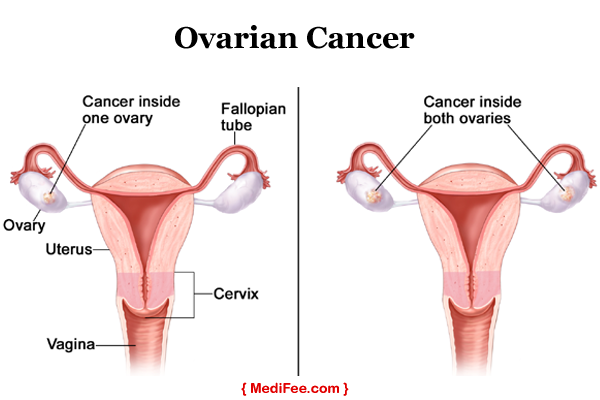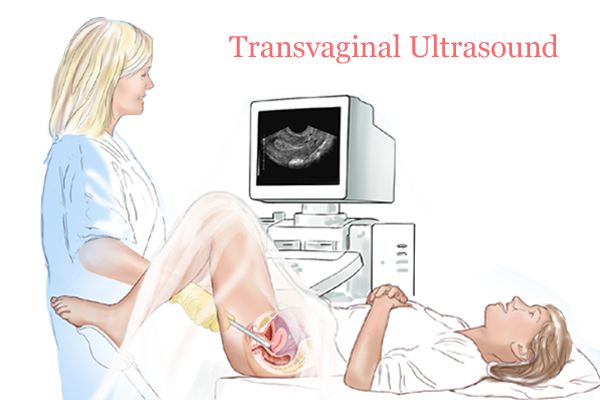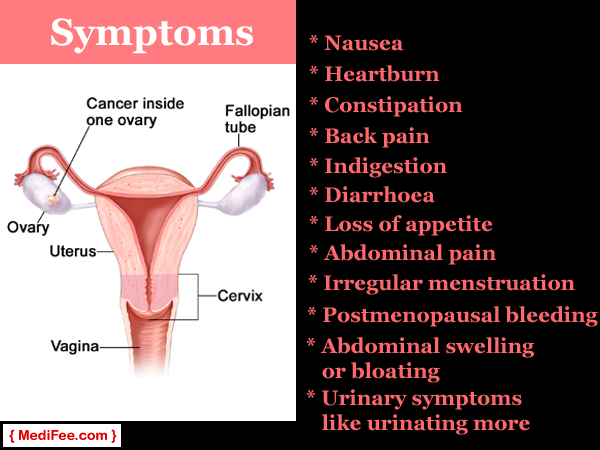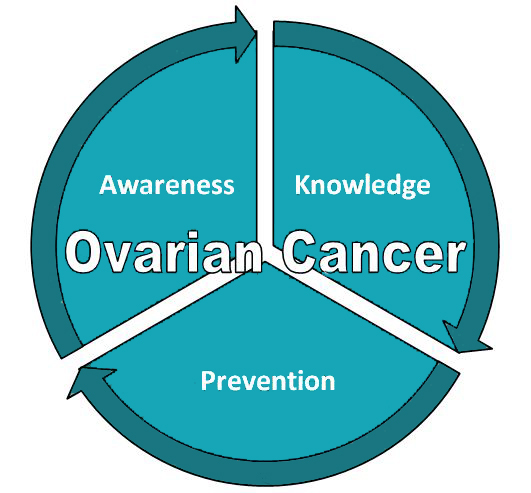The human female reproductive system is made up of- ovaries, uterus, vagina, fallopian tubes, vulva, breasts and mammary glands. All these
components have separate functions to perform in the whole child-bearing process. Ovaries, also known as the female gonads are located on the left and right sides of the uterus. Although the size of an ovary is very small, like that of an almond, its function is extremely vital.
Ovaries produce female hormones (estrogen and progesterone) and eggs or ova. During each monthly menstrual cycle, one ovary releases one egg that travels through a fallopian tube to the uterus. These ovaries have many other functions to play, controlling the development of female body characteristics being one of those. 
Ovarian cancer is one of the most common cancers occurring in women. It starts in an ovary and can spread to other organs including liver and lungs. If diagnosed and treated early, this cancer is curable to a great extent. A combination of surgery, chemotherapy and radiation therapy is usually required for the treatment process. Every girl or woman must be aware of ovarian cancer and the diagnosis, risk factors, symptoms and prevention steps associated with this disease.
Diagnosis:
Although there are some screening tests for detecting ovarian cancer, unfortunately these tests have not been 100% successful. However, the two most popular tests are:
-
TVUS:
TVUS, that is, transvaginal ultrasound is the test to see whether there is any tumour in the ovary. This test uses ultrasound waves to examine the fallopian tubes, uterus and ovaries. An ultrasound wave is put into the vagina to examine all these areas.
 However, this test cannot tell whether a tumour, found in the ovary is cancerous or not. For this reason, it is not used as a standard diagnostic test in the way mammograms are used for detecting breast cancer.
However, this test cannot tell whether a tumour, found in the ovary is cancerous or not. For this reason, it is not used as a standard diagnostic test in the way mammograms are used for detecting breast cancer. -
CA-125 protein test:
Women who have ovarian cancer may have higher levels of CA-125, a protein found in the blood. This test can be used to know the existence of a tumour in order to guide the treatment process for women having ovarian cancer; since the higher levels of CA-125 may go down if the treatment is working properly.
Unfortunately checking the levels of this protein is not a successful screening test for this cancer. So what is the exact problem? There are many conditions other than ovarian cancer that may raise the levels of this protein. Again, all women with ovarian cancer do not have higher levels. If a doctor is dissatisfied with the result of this test, they may also consider prescribing a TVUS test, besides ordering for a second CA-125 level test.
Symptoms:
Like many other cancers, symptoms of ovarian cancer are not very transparent in the initial stages. In most patients, symptoms have been present for some time before the disease gets detected. Sometimes, the signs may be misdiagnosed as some other conditions like bowel syndrome. In the initial days or months, a woman may not have any pain at all. 
However the common symptoms are:
- Abdominal swelling or bloating
- Abdominal pain
- Feeling full promptly
- Loss of appetite
- Feeling weak
- Urinary symptoms like urinating more often or on a urgent basis
- Back pain
- Irregular menstruation
- Postmenopausal bleeding
- Diarrhoea
- Indigestion
- Constipation
- Nausea
- Heartburn
- Unexplained weight gain or weight loss
These symptoms can vary according to the subtype. Most of these symptoms are conditions for many other diseases. That is why the diagnosis of ovarian cancer at an early stage is very difficult. A woman, who experiences any of these conditions for more than 2 weeks on a regular basis, must talk with her gynaecologist.
Risk factors for ovarian cancers are:
- Family History: Mutations in BRCA1 or BRCA2 genes is linked with ovarian cancer in most cases. Increased risk of ovarian cancer can come from both mother’s and father’s side (relatives with ovarian cancer from both sides).
- Obesity: Obese women with a BMI of 30 or more have higher risks.
- Age: Ovarian cancer is rare in women below 40. The risk increases once a woman has entered menopause. Again majority of the cases show women above 60 getting this cancer.
- Birth control or oral contraceptives: Women using these pills have lower risk. The risk is lower with women who had used these for 3 or more years.
- Fertility drugs: In many research studies, researchers have found that women using fertility drugs for longer time may have greater risk of developing ovarian tumors.
- Infertility: Infertile women, in comparison to their fertile counterparts may be at greater risk of being attacked with this deadly disease.
Besides these, hormone replacement therapy, breast cancer, colorectal cancer and having peutz-jeghers syndrome also raise the risk of ovarian cancer.
Prevention:
There is no proven way to prevent ovarian cancer. Yet, a woman may take the following steps to reduce her chances of getting the disease:
- Pregnancy
- Breastfeeding
- Taking oral contraceptives for more than three years
- If a woman had gone for hysterectomy (removal of the uterus and/ or cervix), a tubal litigation (having both the fallopian tubes tied in
order to prevent pregnancy) or salpingectomy (removal of the fallopian tubes), she might have reduced risks of getting cervical cancer.
- If a women with mutations in the BRCA1 or BRCA2 genes goes for the surgical removal of ovaries and the fallopian tubes after bearing her child, she can also have greater chances of having preventing ovarian cancer. Research studies show that almost 5% to 10% of all breast cancers and 15% of all ovarian cancers are caused due to mutations in BRCA1 and BRCA2 genes. Going for this surgery reduces the risks from 40% to 70% in breast cancers and 70% to 96% in ovarian cancer.
- Going for regular pelvic tests is another precautionary measure. Your gynaecologist may feel certain abnormalities in the pelvic area and ovarian tumours may be one of those.
Of course before going for any surgical procedures for the prevention of ovarian cancer, you must talk with your gynaecologist. You must understand the risks and side effects of this surgery and compare those with the risks of developing ovarian cancer. If necessary, taking a second opinion may also be considered.
I m 16years old i have half in size uterus with normal overies and still periods not started so advize me u have any suggestions